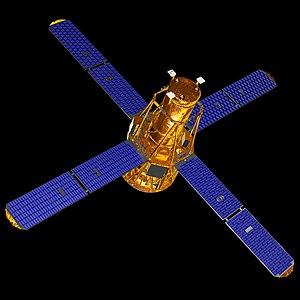Reuven Ramaty High Energy Solar Spectroscopic Imager
| RHESSI | |
|---|---|

|
|
| Type: | Space telescope |
| Country: |
|
| Operator: |
|
| COSPAR-ID : | 2002-004A |
| Mission dates | |
| Dimensions: | 304 kg |
| Begin: | February 5, 2002, 20:58 UTC |
| Starting place: | Mayport Drop Zone |
| Launcher: | Pegasus-XL |
| Flight duration: | 2 years ( originally planned ), 16 years ( achieved ) |
| Status: | Out of service |
| Orbit data | |
| Rotation time : | 96.5 min |
| Orbit inclination : | 38.0 ° |
| Apogee height : | 607 km |
| Perigee height : | 579 km |
The Reuven Ramaty High Energy Solar Spectroscopic Imager (RHESSI) (also Explorer 81 ) is a former space telescope of NASA with the participation of other US and Swiss institutions. It was used for solar observation in the X-ray and gamma range. In this high-energy electromagnetic radiation, solar corona and solar flares were observed and the physical mechanisms of particle acceleration in these events ( reconnection ) were investigated.
purpose
RHESSI observed the sun in the X-ray and gamma range at energies from 3 keV to 17 MeV. Using a system of grid collimators in conjunction with the rotation of the spin-stabilized satellite, the sun could be examined with a resolution of 2 to 36 arc seconds, depending on the energy range. The cooled semiconductor detectors used have an energy resolution between 1 keV at low energies and 5 keV at high energies. This combination of high spatial and spectral resolution was first realized in this energy range at RHESSI. In addition to observing the sun, RHESSI also examined gamma radiation pulses that are generated in thunderstorm regions on earth.
Mission history
The launch took place on February 5, 2002 with an aircraft-based Pegasus rocket. The carrier aircraft type L-1011 took off at 19:29 UTC from Cape Canaveral Air Force Station on. The drop took place at 8:58 pm in the Mayport Drop Zone off the coast of Florida at 29 ° North, 78.5 ° West .
Previously known as the High Energy Solar Spectroscopic Imager (HESSI), the satellite was renamed on March 29, 2002 in honor of the astrophysicist Reuven Ramaty . The originally planned lifespan was two years. Due to technical problems, the mission ended on October 1, 2018.
Web links
- NASA Goddard Space Flight Center: RHESSI (English)
- Astrophysical Institute Potsdam: Reuven Ramaty High Energy Solar Spectroscopic Imager
- RP Lin, BR Dennis, GJ Hurford et al. : The Reuven Ramaty High-energy Solar Spectroscopic Imager (RHESSI) . In: Solar Physics . tape 210 , 2002, pp. 3–32 , doi : 10.1023 / A: 1022428818870 (English, springer.com [PDF; 619 kB ]).
Individual evidence
- ↑ a b RHESSI status. NASA, accessed on November 2, 2018 (English): “October 1, 2018 - END OF RHESSI MISSION. The RHESSI spacecraft will automatically decommission itself "
- ↑ RHESSI in the NSSDCA Master Catalog , accessed on October 4, 2012 (English).
- ↑ HESSI in the Encyclopedia Astronautica , accessed on February 21, 2018 (English).

